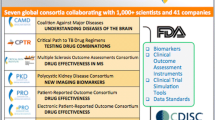Abstract
This work aimed to provide an understanding of the current use and regulatory acceptability of patient-reported outcome (PRO) measures in labeling claims for central nervous system (CNS) agents. A subset of CNS agents was identified from all New Drug Approvals and Biologic License Applications for new drugs approved in the US from January 2006 to June 2012. Clinician-reported outcomes (ClinROs) (62%) and PROs (38%) were the most widely used primary outcome measures. The PROs were frequently used in combination with ClinROs. Twelve PRO claims were granted across 41% of CNS drug approvals: 83%, symptoms; 17%, functioning. The PROs are frequently utilized as primary and secondary end points in CNS agents, and labeling claims are granted at higher levels than for non-CNS agents (41% vs 24%, respectively). These claims are granted at a lower rate than expected, given that direct patient input may lend valuable insight to treatment impacts in most CNS diseases.
Similar content being viewed by others
References
World Health Organization. Neurological disorders. Public health challenges. https://www.who.int/mental_health/neurology/neurological_disorders_report_web.pdf.
Soni A. The top five therapeutic classes of outpatient prescription drugs ranked by total expense for adults age 18 and older in the U.S. civilian non-institutionalized population, 2005. Statistical Brief #198. January 2008. https://meps.ahrq.gov/data_files/publications/st198/stat198.shtml.
IMS Institute for Healthcare Informatics. The use of medicines in the United States: review of 2010. Available at: https://www.imshealth.com/imshealth/Global/Content/IMS%20Institute/Documents/IHII_UseOfMed_report%20.pdf. Accessed February 25, 2013.
Tufts Center for the Study of Drug Development. Impact report: analysis and insight into critical drug development issues. Pace of CNS drug development and FDA approvals lags other drug classes. Volume 14. March/April 2012. Available at: https://csdd.tufts.edu/files/uploads/mar-apr_2012_ir_summary.pdf. Accessed April 20, 2013.
Johnson GS. Re-purposing translational medicine and other strategies for de-risking CNS. 2007. Available at: https://knowledgebase.definedhealth.net/wp-content/uploads/2008/02/derisking-in-cns-2007-5.pdf. Accessed February 25, 2013.
US Department of Health and Human Services. Guidance for industry. Patient-reported outcome measures: use in medical product development to support labeling claims. Available at: https://www.fda.gov/downloads/Drugs/GuidanceComplianceRegulatoryInformation/Guidances/UCM193282.pdf. Accessed February 25, 2013.
Fayers PM, Machin D. Quality of Life: The Assessment, Analysis and Interpretation of Patient-Reported Outcomes. 2nd ed. Chichester, UK: John Wiley and Sons Ltd; 2007.
Kobak KA, Kane JM, Thase ME, Nierenberg AA. Why do clinical trials fail? The problem of measurement error in clinical trials: time to test new paradigms? J Clin Psychopharmacol. 2007;27:1–5.
Gnanasakthy A, Mordin M, DeMuro C, Clark M, Fehnel S, Copley-Merriman K. A review of patient-reported outcomes labels in the US: 2006–2010. Value Health. 2012;15:437–442.
Willke RJ, Burke LB, Erickson P. Measuring treatment impact: a review of patient-reported outcomes and other efficacy endpoints in approved product labels. Control Clin Trials. 2004;25:535–552.
Koivumaa-Honkanen HT, Honkanen R, Antikainen R, Hintikka J, Viinamäki H. Self-reported life satisfaction and treatment factors in patients with schizophrenia, major depression and anxiety disorder. Acta Psychiatr Scand. 1999;5:377–384.
Fleischhacker WW, Rabinowitz J, Kemmler G, Eerdekens M, Mehnert A. Perceived functioning, well-being and psychiatric symptoms in patients with stable schizophrenia treated with long-acting risperidone for 1 year. Br J Psychiatry. 2005;187:131–136.
Coghill D, Danckaerts M, Sonuga-Barke E, Sergeant J; ADHD European Guidelines Group. Practitioner review: quality of life in child mental health. Conceptual challenges and practical choices. J Child Psychol Psychiatry. 2008;50:544–561.
Chue P. The relationship between patient satisfaction and treatment outcomes in schizophrenia. J Psychopharmacol. 2006;20:38–56.
McCabe R, Saidi M, Priebes S. Patient-reported outcomes in schizophrenia. Br J Psychiatry. 2007;191:s21–s28.
US Department of Health and Human Services. Qualification process for drug development tools. Available at: https://www.fda.gov/downloads/Drugs/GuidanceComplianceRegulatoryInformation/Guidances/UCM230597.pdf. Accessed February 25, 2013.
Woodcock J, Woosley R. The FDA critical path initiative and its influence on new drug development. Annu Rev Med. 2008;59:1–12.
Author information
Authors and Affiliations
Corresponding author
Rights and permissions
About this article
Cite this article
Gnanasakthy, A., DeMuro, C., Clark, M. et al. Role of Patient-Reported Outcome Measures in the Assessment of Central Nervous System Agents. Ther Innov Regul Sci 47, 613–618 (2013). https://doi.org/10.1177/2168479013495686
Received:
Accepted:
Published:
Issue Date:
DOI: https://doi.org/10.1177/2168479013495686




